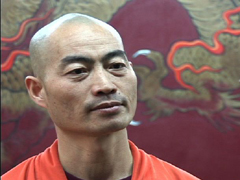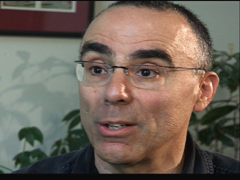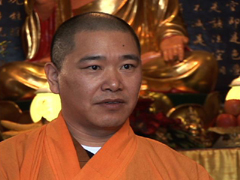In This Episode << SLIDE LEFT TO SEE ADDITIONAL SEGMENTS
Shaolin Fighting Monks
BOB ABERNETHY, anchor: Think of Buddhist monks and you probably imagine practitioners sitting stark still trying to quiet their minds. Who knew that the violent martial art kung fu has it’s own spiritual foundation? Lucky Severson reports on “action meditation.”
LUCKY SEVERSON: Many people in the Western world think kung fu is all about combat, about beating up the opponent. It’s true that the original kung fu monks were legendary warriors defending one Chinese emperor after the other. But there is another side to this martial art, perhaps the most important one, according to Berkeley professor of religious studies Robert Sharf.
Professor ROBERT SHARF (Center for Buddhist Studies, University of California at Berkeley): They say this is not actually about harming human beings. It’s not even necessarily about defending oneself. It’s really a form of personal cultivation.
SEVERSON: Gay Hobner, a fundraiser for a nonprofit charity, says she has benefited.
GAY HOBNER: I practice kung fu because it’s a combination between going to the gym and the therapist, and it’s also — I found a spiritual home here as well.
SEVERSON: How?
Ms. HOBNER: How? Because I think that the reasons people go to church are the same reasons a lot of us come here — for that sense of spiritual renewal.
SEVERSON: There is a spiritual side to kung fu. It’s called Chan Buddhism, and through it kung fu becomes an instrument of enlightenment.
SHI YAN MING: You must understand they are one, not two. Just like our mental and physical, we have to understand that’s one piece — one body.
SEVERSON: Shi Yan Ming is a 34th-generation Shaolin monk, a kung fu master who defected from China in 1992. He has established a Shaolin temple and kung fu school in downtown Manhattan.
SHI YAN MING: That’s why I defected. I want to spread the Shaolin philosophy of martial arts to the rest of the world.
SEVERSON: A fundamental precept of Buddhism is that the mind must be emptied of all worldly desires through meditation, and only then can a person become enlightened. Yan Ming says that martial arts are “action meditation,” in other words, focusing so intently on the complex moves of kung fu that the mind empties all of life’s anxieties.
Prof. SHARF: The point of Buddhist mediation — there’re many different kinds of mediation — but the point of most of them is the quiet and ultimately still that inner voice, because they believe when we still the inner voice then who we really are comes forward. It just becomes naturally apparent.
Ms. HOBNER: For me this empties my mind. It’s better than any kind of sitting meditation. I’ve done yoga. This does it. You don’t have a thought in your head for two hours, and just that blankness, that for me refreshes me mentally.
SEVERSON: The state of enlightenment is the goal of all Buddhists, but in Chan Buddhism it is not necessarily at the end of a long road of reincarnations.
Prof. SHARF: The Chan school had this doctrine of sudden enlightenment, and they said that you really are already a Buddha, you just don’t understand that. So it’s nothing that you have to acquire through years and years of practice. It’s really something that you just have to let shine through, or to let come forward in the instant, and the moment you let go of all your discursive mental activity, the moment you let go of that inner voice and our inner desires and our wants, including the desire for enlightenment, at that point you’re a Buddha.
SEVERSON: The home and birthplace of Chan Buddhism and Shaolin kung fu is this temple in central China. It dates back 1,500 years and has become a mecca for kung fu students from all over the world.
SEVERSON: Yan Ming started training to become a monk at the Shaolin temple in China when he was only five years old. The training is rigorous and goes on for years. Bright and early each morning, students run up the steps of a steep hill and then crawl back down. As the training advances, the challenges become more strenuous.
Shi Guolin also trained here. He wanted to become a monk when he was a little boy so he could fly. He did earn the revered kung fu title of Shaolin Hero.
SHI GUOLIN: When I was young, I trained kung fu eight hours a day.
SEVERSON: Every day, eight hours?
SHI GUOLIN: Yes.
SEVERSON: Eight years?
SHI GUOLIN: Yeah.
SEVERSON: Shi Guolin is in line to become the next abbot of the Shaolin temple in China. He now operates a temple and school in Flushing, New York. The first and one of the most important aspects of Shaolin kung fu is something called “chi.”
SHI GUOLIN: Chi in body like air.
SEVERSON: So breathing is very important in kung fu?
SHI GUOLIN: Very, very important.
SEVERSON: Yes?
SHI GUOLIN: If no breathing — no life.
SEVERSON: The notion of chi goes back thousands of years. It is considered to be a person’s life force or energy. Cultivating chi, this inner power, is what kung fu is all about.
SHI YAN MING: We walk 10 blocks, we don’t feel tired, that’s chi. If we walk five blocks and your legs feel heavy like 1,000 pounds, you cannot move forward, there’s no chi.
SEVERSON: It takes, for instance, an amazing control of chi to perform some of the martial arts shown here. Yan Ming and Shi Guolin have each performed these death-defying feats many times. There’s yet another side of kung fu — the artistic side. It was on display in San Francisco recently. This was a rehearsal for a performance, a collaboration between Shaolin monks and the acclaimed Lines Ballet company. The artistic director is Alonzo King.
ALONZO KING (Lines Ballet artistic director Alonzo King): A lot of times people will look at their movement and think this looks violent, or it’s preparing for some kind of struggle. But it’s dancing.
SEVERSON: But these students are not interested in dancing kung fu. They’re more interested in the essentials of Shaolin philosophy. That means that while learning martial arts they must also cultivate a sense of ethics, one that encompasses justice, diligence, honesty, hard work, and mental discipline. Melanie Lo has been a student of Shi Guolin for 12 years.
MELANIE LO: He has a term called “monkey mind,” where we’re not focused, and we’re thinking about all these other things in our lives, and then he tells us to bring our self back here, back in the present moment and practice and focus.
SEVERSON: And the ultimate goal of all this practice, this “action meditation,” is a state of enlightenment. Yan Ming says it’s a very happy state to be in.
(to Shi Yan Ming): Have you achieved total enlightenment?
SHI YAN MING: I achieve. I understand myself clearly. Yes.
SEVERSON: What does that feel like?
SHI YAN MING: Feel like Merry Christmas, Happy New Year.
SEVERSON: Yan Ming says kung fu is for everyone no matter what their religion, and that the world would be a more peaceful, happier place with “action meditation.” Then, he says, every day would be a holiday.
For RELIGION & ETHICS NEWSWEEKLY, I’m Lucky Severson in New York City.






